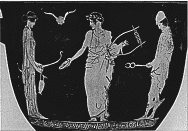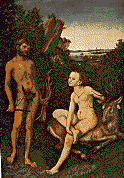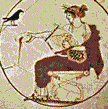
The young woman is nude and stepping out of a pond, her right foot on earth and her left still in the water. She is athletic, light skinned and has platinum-blond waist-length hair, which is loosely bound; in it she wear a silver crescent moon, horns upward. She holds a silver kantharos (cup) in her left hand.
The young man is nude but for a chlamys (cloak), which is decorated with a red lion and roses, and draped over his shoulders; he has cothurni (laced leather buskins) on his feet. In his left hand he holds a spear which shines in the sunlight and is decorated with a feather. He is dark-skinned (reddish to dark brown), beardless, wears a laurel wreath in his longish, blond, curly hair, which shines in the sun in a golden nimbus. Only the right eye of the man is visible, and only the left of the woman. They reach toward each other with their right hands.
Behind the woman is a tree with a snake curling up it, and behind the man there are fir trees and a burning campfire, from which smoke rises. Draped over a nearby branch, as though to dry, is the woman's short, saffron and purple hunting tunic, decorated with a white eagle and lilies; her cothurni are on the ground nearby. In the background are three black hunting dogs, who stand quietly, but look toward the couple; there is a scorpion on the ground behind the man's heel.
This is no ordinary marriage, but an alchemical conjunction of brother and sister. Upon its consummation the masculine poles (consciousness, thought, intuition) will be destroyed, dissolved in the subconscious mother sea; this represents the dissolution that must precede the rejuvenation of the masculine elements. The divine child will consume the mother's substance while it grows in her womb, and she will die in birth, thus obliterating the feminine poles (unconsciousness, feeling, sensation). The child, however, will survive, and manifest a well-tempered balance of all oppositions, thus reincarnating both parents (cf. VIII.Temperance).
This card is incorrectly called "the Lovers," for in the earliest decks it consistently portrays Eros, that is Love, and is so called in the earliest Italian sources (Dummett 112). Note that in some mythological accounts Eros is the son of Hermes (I.Magician) and Aphrodite (II.Empress); see, e.g., Larousse (132). Here, as Master of the Cup, Eros pours a libation of blessing for the couple. (N.B.: Mercury and Venus, his parents, are both cup-bearers - Jung, MC 303.)
 Apollo, Artemis and Hermes (Barclay Painter, 450-440 BCE)
Apollo, Artemis and Hermes (Barclay Painter, 450-440 BCE)
VI.Love represents the marriage of IV.High Priestess and V.High Priest; that is, it is the Alchemical Wedding between the silver Queen of the Night and the golden King of the Day, for the anima wants a man and the animus wants a woman; they yearn for the coniunctio. The King and Queen are at the ends of their reigns; the King is becoming senile and the Queen has put aside her green gown and donned the livid purple, which portends the immanent Love-death of the couple. Hermes appears in the form of Eros; they both throw the dart and are called "archers who shoot without bowstrings." He is Mercury, which unites the Sulphur and Salt, and presides over this Hermetic Marriage by which the light of Moon is emptied into the Sun, and the light of the Sun is emptied into the Moon, and from them both light fills the World. We see this in the eclipse, for the Moon darkens as she turns to face her betrothed, and when she finally comes to him, he too is darkened; the consummation takes place in blackest night. All oppositions are reconciled when Mercury brings about the union of the White Queen of the Silver Crown and the Black King of the Gold Crown: the Water with the Fire, the Earth with the Air, the White Eagle with the Red Lion, the Holy Cup (Grail) with the Sacred Spear. The offspring is the pneumatos, the "harmony of an intermediate spirit," the double-natured Grey Egg, which blends white and black (see VII.Temperance). The double opposition of the four elements is resolved in the Quintessentia. (Jung, MC 35-7, 149, 288-9, 304, 459, Sp. Merc. 230-1; von Franz 111-2, 201; Crowley 80-4; Nichols 131)
The hexagram is the symbol of the sacred union that balances the oppositions, for it is simultaneously the superimposed triangles of Fire and Water, and the superimposed signs of Air and Earth (Nichols 137). Thus all four aspects of the psyche, male and female, immanent and transcendent, are brought together, the conscious and the unconscious united in balance (see also V.High Priest) (von Franz 164). As noted in our discussion of the Minor Arcana, the Pythagoreans say that the hexad is the principle of harmony, for it is the product of the dyad and the triad, which generate every perfect consonance. They also say that it reconciles opposites, is equal to its own parts, and is called Wholeness. In our representation, Eros wears a six-pointed star.
Nevertheless, the numerical value of ERWS O QEOS (Eros Ho Theos, the God Eros) is 1459, which reduces to 9-5+4-1 = 7. Because this love is requited, the numerical value of ERWS KAI ANTERWS (Eros kai Anteros, Love and Answering Love) is 2592, which reduces to 11+2-9+5-2 = 7. The Heptad is the "Second Monad," the impulse toward a new level of manifestation, a new beginning, a new principle of generation, a complete person comprising three psychical elements (mind, spirit and psyche) and four material elements (earth, water, air and fire), to which correspond the three spiritual virtues and the four practical virtues. The Pythagoreans call the Heptad "Fulfillment" and "Threshold of Rebirth." The Heptad is the offspring of the first actual odd and even numbers, the Father (3) and the Mother (4), since 7 = 3+4; also note that the Empress and Emperor are third and fourth in their Hendecads. (The numbers 1 and 2 are only potential odd and even numbers.) (Schimmel 128; TA 57-8; see also the meaning of Zeta, above, and see the description of the Sevens in the Minor Arcana.)
In Empedocles (frr. 17, 21, 22, 26, 35) too, it is Love (Philotes) who mixes and unites the four elements, making One out of Many. According to Diogenes Laertius (VIII.76), Hera (Empress) = Earth, Aidoneus (Emperor) = Air, Nestis (Priestess) = Water, Zeus (Priest) = Fire.
In the marriage of heaven and earth, the King's downward thrust meets the Queen's upward arch, and the newlyweds tangle violently, like fighting lions, dogs, dragons or wolves. Indeed the King must die at the moment of consummation: Some say Cupid's dart, the telum passionis, pierces his heart. Others say the groom's head is bitten off by the Bride-snake. Yet others say he is torn by black dogs of Hecate, as Actaeon was after he feasted on the naked form of Artemis, for such is the fate of whoever is Betrothed to the Moon (Lunae Sponsus). The Bride of the Sun (Soli Sponsa) in turn is fated to die in childbirth, and so the two souls of the parents yield to the one soul of the Child. King Consciousness loses his absolute authority, as in turn does Queen Unconsciousness; with the Child there will be a balance of psychic powers. (Jung, MC 29-34, 295, 304, 360, 380)
This theme is well known from the Sumerian cult of Inanna (Ishtar) and Dumuzi (Tammuz). She is Queen of Heaven and Earth, a love goddess and a warrior goddess; he is the Shepherd-King, the Wild Bull, who is given his arms by Inanna. Some time after their sacred marriage, Inanna was responsible for the death of Dumuzi, for when she was trapped in the underworld, she sent demons to take him as a substitute, and so he descended into the darkness. According to some legends Inanna gave birth to Shara, her Divine Son. The sacred marriage of the High Priest and High Priestess also corresponds to the sacred marriage of Shamash (Utu), the sun god, and Aya (Sherida), a goddess of light. (Jacobsen 47, 205-232; Wolkstein & Kramer x, 51-89, 161; Black & Green s.vv. Dumuzi, Inana, Shara, Sherida; Kramer SMR passim)
Crowley (80, 101-2) observes that Love and Temperance are twin cards, a complementary pair: Solve et Coagula. This is additional evidence that they should be consecutive, as in the Ferrara sequence and ours (6, 7), and not separated as in most contemporary decks (6, 14). That VI.Love corresponds to Solve is evidenced by the alchemical tradition that the sacred marriage takes place in the spiritual waters (aqua aeris) of Ocean (the "Meridian Sea," the "Sea of the Indians," the "Nile of Egypt," cf. the Aegean Festival in Goethe's Faust, pt. II). Often the King drowns in these waters, the Ocean of the High Priestess. This spiritual water, which brings about the union, is just Mercury in another manifestation. As Mercury, the waters dissolve the Old Emperor, but all the planets infuse the bath with their influence. As Venus (Empress) the waters engulf the Old Emperor, and as both content and container she becomes Luna (High Priestess), who carries the Child hidden in her womb. (Jung, MC 314-6, 358-9, 461)
As far as I've been able to tell, before the twentieth century the Lovers are consistently shown wearing clothes, though nudes may appear on other cards (e.g. the Star). Nevertheless, Apollo is generally shown nude, and of course Artemis was naked when spied by Actaeon. In alchemy, undressing represents the exposure of the soul, the discarding of the Cloak of Darkness representing the nigredo (Jung, MC 50).
VI.Love in the Visconti-Sforza tarot is similar to ours: woman on right, man on left, right hands clasped, blindfolded naked Cupid above, aiming a dart at the man. The general scene is depicted in many alchemical illustrations, for example the second woodcut of the Rosarium Philosophorum (1550) and many of its engraved variants: the couple joins their right hands, and a dove with a six-pointed star descends from above (e.g. Fabricius figs. 35, 36, 38). From the couple's perspective, the solar king is on the right and the lunar queen on the left, which is the usual alchemical arrangement. Apollo's right eye is visible and Artemis' left because, according to ancient tradition, the Sun corresponds to the right eye and the moon to the left (Jung, MC 97). Apollo reaches out his right hand as a sign of kindness and holds the Spear of severity in his left hand (Godwin 30). Similarly, Artemis reaches toward him with her right hand, and retains the sacred Cup in her left. For the color of Artemis' tunic, see Larousse (111, 121-2) and OCD (s.v. Artemis).
The Lovers combine all the elements into a balanced whole. The element Fire is represented by the fir tree and the campfire; the element Air is represented by the feather and the smoke; the element Water is represented by the pond and the patera; the element Earth is represented by the ground and snake. The Bride-snake also symbolizes wisdom and redemption arising from control of the Kundalini power (Case 88). There are three black dogs because, as Jung (SM 221) observes, triads are characteristic of the underworld (e.g. three-faced Hecate and Cerberus).
 Apollo and Diana (Lucas Cranach, 1530)
Apollo and Diana (Lucas Cranach, 1530)
Although Artemis is known as a virgin goddess, she was not totally immune to Cupid's dart. She fell in love with the beautiful hunter Orion, but he died, either stung by a scorpion (Scorpio) because he ravished her, or shot by Artemis herself, who was tricked into the deed by Apollo. For there is also a tradition that Apollo was infatuated with Artemis, his sister, and ravished her on his altar at Delos. (Incidentally, Orion's dog, Sirius, was also killed by the scorpion.) (Larousse 121, 144; Willis 139)
Similarly, in the forest Apollo once saw the nymph Cyrene, a huntress, wrestling a lion (cf. IX.Fortitude). He immediately fell in love with her and seduced her; she later bore his child. More relevant to this card is the story of Coronis. When she was already pregnant with Apollo's child, she married another, and Apollo in anger slew the couple. While Coronis burned on the funeral pyre, Apollo snatched from her womb the baby, who grew up to be Asclepius, the Healer, also known as Soter - Savior (OCD). Coronis is named for the crow, who informed Apollo of the marriage, and was blackened for bringing the unwelcome news. When Asclepius tried to bring Orion back to life, Zeus blasted him with a thunderbolt. (Larousse 118) In all these cases we see the theme of the alchemical blackening (nigredo) followed by the release of the sun spirit destined for purification and rebirth.
 Apollo and the Crow (Sotades workshop (c. 460 BCE)
Apollo and the Crow (Sotades workshop (c. 460 BCE)
Trump VI.Love represents the Triumph of Love, that is, the triumphal procession of Eros. In his Trionfi (Triumphs) Petrarch describes the scene: Cupidus rides in a fiery chariot leading his enslaved captives: emperors and empresses, priests and priestesses, gods and mortals - none are exempt. Pictorial representations of the Triumphs were common in the Renaissance (for examples see D. D. Carnicelli's edition of Lord Morley's Tryumphes of Fraunces Petrarcke, Harvard Univ. Press, 1971). Moakley (ch. 4) has a general discussion of Triumphal processions as they relate to the tarot trumps, and has speculated about the Triumph of Love (p. 14). In dice, the Triumph of Love (Trumps I - VI) is represented by the first row of the Water Hexactys, comprising all the rolls with at least one ace. In the Fire Hexactys the Triumph of Love is the first three rows, comprising the rolls in which the higher die is an ace, deuce or trey. It is likewise the first three rows of astragali rolls (see the Introduction to the Maj. Arc. for details).
This is as much the triumph of Mercury as of Venus, but we've seen that they are closely related and in a sense identical (see I.Magician). In the Tripus Chimicus of Sendivogius (1628) we see Mercury on a triumphal chariot drawn by a cock and a hen; behind him a pair of naked lovers embrace (Jung, SM 231).
Vergil said, "Omnia vincit Amor, et nos cedamus Amori" - "Love conquers all, and we must give in to Love" (Ecloga 69).
 Send comments about this page
Send comments about this page
Last updated
Mon Jun 7 16:56:11 EDT 1999